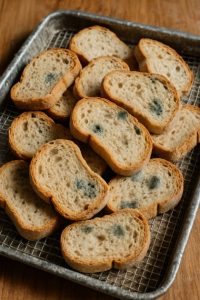
You grab a slice of bread only to find it dry, hard, and less than appetizing. Instinctively, you think of tossing it—but then a voice chimes in (maybe your mother-in-law’s): “Don’t waste it!” Now you’re stuck between guilt and food safety concerns.
So, is stale bread still good? Or is it better to err on the side of caution?
In this practical guide, we’ll explore what stale bread really is, when it’s safe to eat, and why it’s often worth saving. You’ll also discover easy ways to revive it, creative culinary uses, and insights from chefs who view stale bread not as trash—but as potential.
1. What Is Stale Bread, Really?
Stale bread isn’t spoiled—it’s just dry. As bread ages, it loses moisture, and the starches crystallize in a process called retrogradation. This often happens within days, especially if the bread is left exposed to air.
While it might feel tough or look less appealing, stale bread is usually still perfectly edible—as long as it shows no signs of mold.
2. Is Stale Bread Safe to Eat?
Yes—if there’s no mold.
Mold is the dealbreaker. Look for fuzzy spots in green, white, or black. If you see any, even on a corner, toss the whole loaf—mold spores can spread invisibly.
But if it’s just dry and smells normal, your bread is safe. You may not want to eat it plain, but don’t count it out just yet.
3. Why Reducing Bread Waste Matters
Bread is one of the most wasted foods globally, contributing to the 1.3 billion tons of food discarded each year. But food waste isn’t just about what’s on your plate—it’s also about the resources behind it: water, energy, labor, and transportation.
Wasted food in landfills also produces methane, a potent greenhouse gas. So finding a second life for your stale bread isn’t just thrifty—it’s good for the planet.
4. How to Revive Stale Bread
Before giving up, try this simple trick to restore some life to your loaf:
-
Lightly sprinkle the crust with water
-
Wrap the bread in foil
-
Bake at 350°F (175°C) for 10 minutes
The heat rehydrates the bread and softens the crust, making it almost like fresh-baked again.
5. Recipes That Welcome Stale Bread
Even if your bread isn’t toast-worthy, it can still shine in dishes where texture takes a back seat:
-
French Toast
-
Bread Pudding
-
Stuffing or Dressing
-
Savory Strata
-
Panzanella (Italian Bread Salad)
These dishes rely on slightly dry bread to absorb flavors and hold shape—making stale bread the ideal base.
6. Internet Hacks to Try at Home
Social media is filled with quick, clever uses for old bread. A few fan favorites:
-
Homemade Breadcrumbs: Pulse dry bread in a food processor and store in an airtight container. Use to coat chicken, top casseroles, or thicken soups.
-
Crispy Croutons: Cube the bread, toss with olive oil and seasoning, then bake until golden. Perfect for salads, soups, or snacks.
7. Does Stale Bread Lose Nutritional Value?
Not really. Stale bread retains most of its original nutrients—carbohydrates, fiber, protein, and some vitamins and minerals. The main change is texture, not content.
If the bread was fortified or enriched, minor nutrient losses might occur over time, but not enough to make a major nutritional impact unless it’s extremely old.
